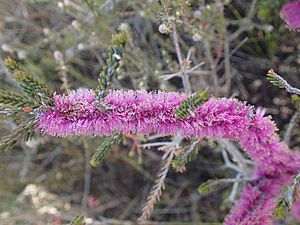Corky-bark honey-myrtle facts for kids
Quick facts for kids Corky honeymyrtle |
|
|---|---|
 |
|
| Melaleuca suberosa in the Cape Le Grand National Park | |
| Scientific classification | |
| Genus: |
Melaleuca
|
| Species: |
suberosa
|
The Melaleuca suberosa, also called the corky honeymyrtle, is a special kind of shrub. It belongs to the myrtle family, called Myrtaceae. This plant grows naturally only in the southern part of Western Australia.
It's easy to spot this shrub because of its unique look. It has small leaves packed closely together. Its bark feels like cork, and it has pretty pink flowers. These flowers grow along parts of the branches that don't have leaves.
Contents
What Does the Corky Honeymyrtle Look Like?
The corky honeymyrtle is a small shrub. It usually grows to about 1 meter (3 feet) tall. Its bark is grey, corky, and has deep grooves.
The branches and leaves are smooth, except when they are very young. The leaves are small, about 3 to 6.5 millimeters long. They are also very narrow, only about 0.8 to 1.5 millimeters wide. These leaves grow close together near the ends of the branches. They are shaped like a narrow oval and have tiny bumps on their top surface.
Flowers and Fruit
The flowers of the corky honeymyrtle are a deep pink or purple color. They grow on the sides of older branches and are partly hidden in the wood. Only the petals, the central part (style), and the stamens (which hold pollen) can be seen.
The petals are small, about 2 to 3.2 millimeters long. They fall off as the flower gets older. The stamens are grouped into five bundles around the flowers. Each bundle has 9 to 15 stamens.
This plant usually flowers between July and January. After the flowers, it grows woody fruits. These fruits are like small capsules, about 2 to 3 millimeters long. They are round and grow along the branches.
Where Does the Corky Honeymyrtle Grow?
The corky honeymyrtle is found in a large area of Western Australia. You can see it between the towns of Albany and Cocklebiddy. It grows in different types of areas called biogeographic regions, like the Esperance Plains and Jarrah Forest.
This shrub likes to grow in sandy, stony, or gravelly soils. You can find it on flat plains, in swampy areas, and on low hills.
How is it Protected?
The corky honeymyrtle is doing well! The Government of Western Australia's Department of Parks and Wildlife says it is "not threatened." This means there are enough of these plants, and they are not in danger of disappearing.
Using the Corky Honeymyrtle in Gardens
People in southern Australia sometimes plant the corky honeymyrtle in their gardens. It's a tough plant that prefers sunny spots. It can handle frost and different kinds of soil. However, it's harder to grow in very warm, wet places like tropical or subtropical climates.
Images for kids



